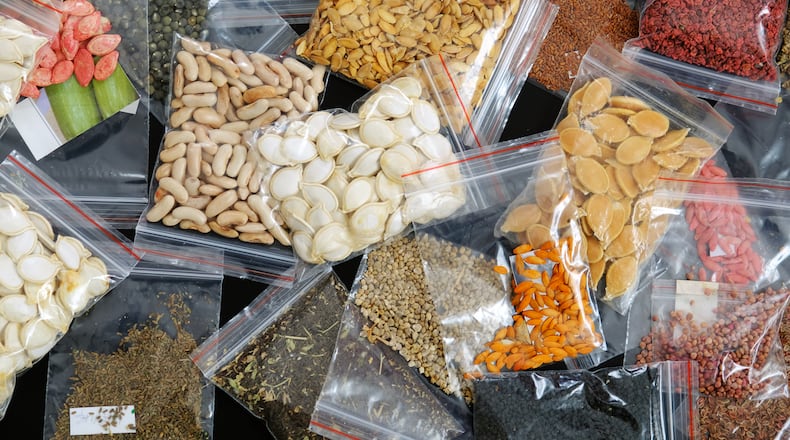The Miami Township Branch of the Dayton Metro Library recently offered an insightful look at seed saving, giving the community an opportunity to gain the necessary skills to start saving their own garden seeds. Issues regarding terminology, pollination, processing, storage and more were discussed in the one-hour presentation.
“The Seed Saving initiative is part of the Library’s broader commitment to sustainability, education and community engagement,” said Claudine Bennett, external relations manager at Dayton Metro Library.
Credit: Getty Images
Credit: Getty Images
The presentation was given by Yvonne Dunphe, an Ohio State University Extension master gardener.
“The thing about seed saving is you really have to know your plants,” Dunphe said. “When you’re starting, keep it simple. Try to limit how many things you’re trying to save of the same kind of plant. If you’re trying to save seven different kinds of tomato plants, the likelihood that they may have cross-pollinated is high. But if you’re only growing little cherry tomatoes, the likelihood that that’s what you’re going to get is higher.”
Dunphe noted the particular challenge of planting peppers.
“People will plant spicy peppers next to green peppers and they cross-pollinate,” she said. “When you plant peppers, you (should) plant more mellow peppers in one area and the others farther away.”
In addition, the simplest starting point for seed saving involves planting annuals such as tomatoes, beans, peas and peppers. Annuals have seeds that require little or no special treatment before storage.
“They start easy and have flowers that are self-pollinating,” Dunphe said. “Also, when you’re picking plants you’re saving seed from (ask yourself) what you’ll have to do to plant them to make them grow. If you’re not willing to do that why are you saving the seed? So pick things that are easier like coneflowers and marigolds.”
Credit: Jessica Damiano
Credit: Jessica Damiano
Biennials such as carrots and onions are of a more difficult variety.
“Seeds from biennial crops are harder to save since the plants need two growing seasons to set seed,” Dunphe said.
There’s also a major question gardeners must ask themselves when considering saving seed: What do you actually want to grow?
“What is something that either brings back memories or you can’t find very easily?” Dunphe said. “Sometimes people gather lots of stuff and they don’t always plant it until late. Then they wonder why saving seed didn’t work because some things didn’t grow. But how did they store it? How long did they have them? Did they label the seeds? There are a lot of things that come with seed saving in order to make it useful.”
She also discussed the “line in the sand” that comes with saving seed.
“Can you do it as well as nature can?” Dunphe said. “There are some native plants like green dragon or Jack-in-the-pulpit that look very similar but after they flower they have a really beautiful seed head that’s red and are berries. It works so much better to have nature do it — they drop to the ground and go through everything they need to go through. And if you really want more of them, you dig a few up the following year."
Planning for success
Dunphe offered the following seed saving tips:
- Begin early — winter
- Make a plan or chart
- Get your seed catalog
- Determine your needs or wants
- Determine your space
- Start small
- Get a good pair of pruners
- Check your zone and average first frost date
Noteworthy books
Dunphe’s recommended reading includes:
- “Seed to Seed” by Suzanne Ashworth
- “Secrets of Plant Propagation: Starting Your Own Flowers, Vegetables, Fruits, Berries, Shrubs, Trees, and Houseplants” by Lewis Hill
- “The Seed Garden: The Art and Practice of Seed Saving” by Jared Zystro and Micaela Colley
Productive purpose
Starting off right sets the pace for productive seed saving.
“Planning helps keep your focus tight on which plants you’ll want to grow and collect seed from,” Dunphe said. “And then you prepare how you’re going to collect it, dry it and store it. In order to collect seed, you have to plant correctly. You also need to do a soil test.”
Following the presentation, a variety of seeds were available for the registered guests. Bennett hopes the community continues to embrace the Dayton Metro Library’s outreach.
“Programs like Seed Saving expand access to essential resources, promote health and well-being and support food security,” Bennett said. “They also bring new faces into our branches, reinforcing Dayton Metro Library’s role as a vibrant community hub.”
For more information, visit extension.osu.edu/home.
ENVIRONMENT & SUSTAINABILITY CONTENT
Have a story suggestion related to environment and sustainability? Contact Reporter Russell Florence Jr. at russell.florence@coxinc.com. Sign up for his weekly things to do email newsletter at daytondailynews.com.
About the Author




